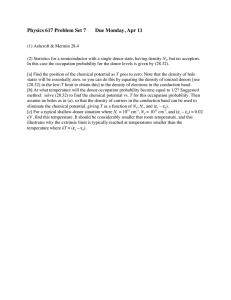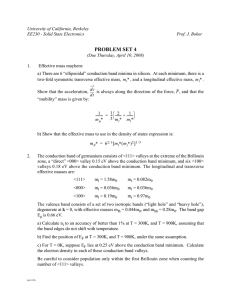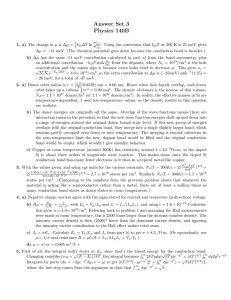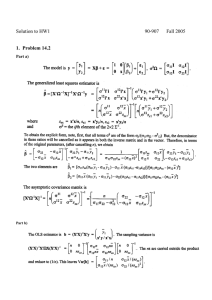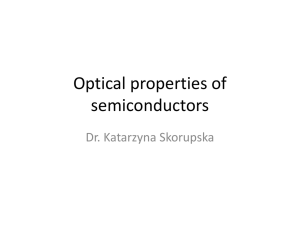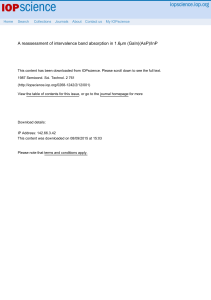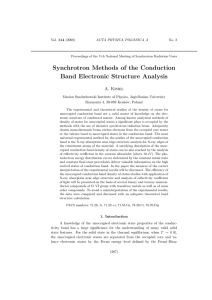1 (a) The number of states per unit volume between the bottom of
advertisement
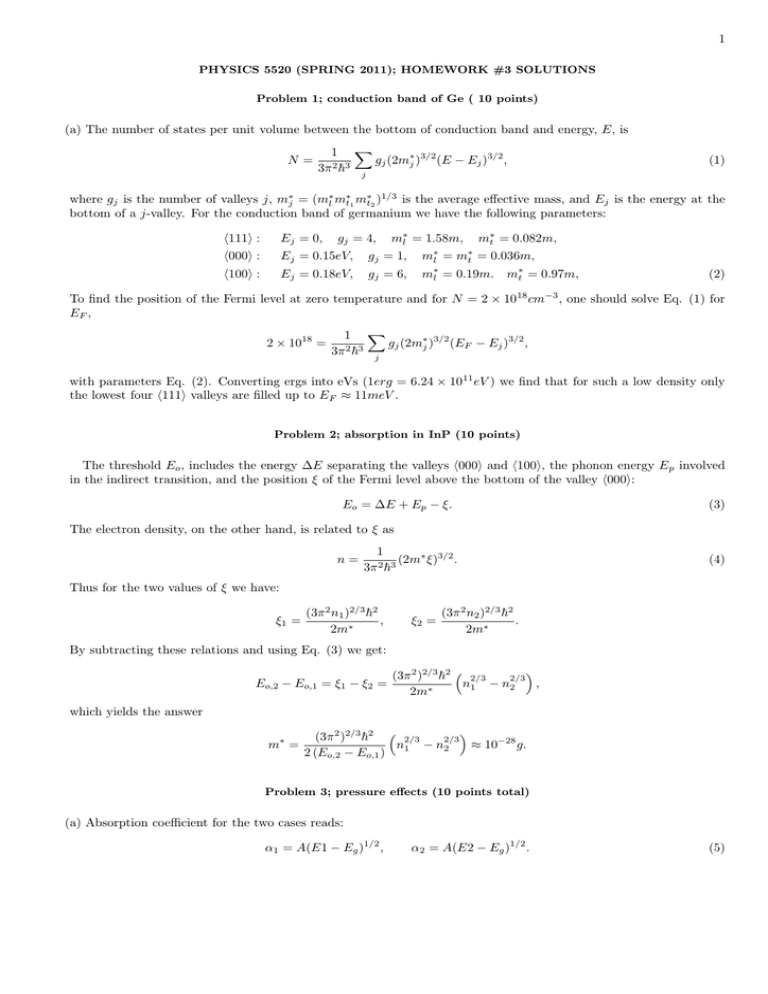
1 PHYSICS 5520 (SPRING 2011); HOMEWORK #3 SOLUTIONS Problem 1; conduction band of Ge ( 10 points) (a) The number of states per unit volume between the bottom of conduction band and energy, E, is N= 1 X gj (2m∗j )3/2 (E − Ej )3/2 , 3π 2 ~3 j (1) where gj is the number of valleys j, m∗j = (m∗l m∗t1 m∗t2 )1/3 is the average effective mass, and Ej is the energy at the bottom of a j-valley. For the conduction band of germanium we have the following parameters: h111i : Ej = 0, gj = 4, h000i : h100i : Ej = 0.15eV, Ej = 0.18eV, m∗l = 1.58m, gj = 1, gj = 6, m∗t = 0.082m, m∗l = m∗t = 0.036m, m∗l = 0.19m. m∗t = 0.97m, (2) To find the position of the Fermi level at zero temperature and for N = 2 × 1018 cm−3 , one should solve Eq. (1) for EF , 2 × 1018 = 1 X gj (2m∗j )3/2 (EF − Ej )3/2 , 3π 2 ~3 j with parameters Eq. (2). Converting ergs into eVs (1erg = 6.24 × 1011 eV ) we find that for such a low density only the lowest four h111i valleys are filled up to EF ≈ 11meV . Problem 2; absorption in InP (10 points) The threshold Eo , includes the energy ∆E separating the valleys h000i and h100i, the phonon energy E p involved in the indirect transition, and the position ξ of the Fermi level above the bottom of the valley h000i: Eo = ∆E + Ep − ξ. (3) The electron density, on the other hand, is related to ξ as n= 1 (2m∗ ξ)3/2 . 3π 2 ~3 (4) Thus for the two values of ξ we have: ξ1 = (3π 2 n1 )2/3 ~2 , 2m∗ ξ2 = (3π 2 n2 )2/3 ~2 . 2m∗ By subtracting these relations and using Eq. (3) we get: Eo,2 − Eo,1 = ξ1 − ξ2 = (3π 2 )2/3 ~2 2/3 2/3 n − n , 1 2 2m∗ which yields the answer m∗ = (3π 2 )2/3 ~2 2/3 2/3 n1 − n 2 ≈ 10−28 g. 2 (Eo,2 − Eo,1 ) Problem 3; pressure effects (10 points total) (a) Absorption coefficient for the two cases reads: α1 = A(E1 − Eg )1/2 , α2 = A(E2 − Eg )1/2 . (5) 2 From this system of equations we find: Eg = E1 − E2(α1 /α2 )2 = 1.44eV. 1 − (α1 /α2 )2 Using this value with any of the relations Eq. (5) the coefficient A is found to be A = 10 4 eV−1/2 cm−1 , so that α is given by α = 104 (hν − 1.44)1/2 cm−1 . (b) Converting the relation for absorption coefficient, α = A(hν − Eg )1/2 , to the relation for Eg yields Eg = hν − α2 . A2 From this relation, variation of Eg due to a small change in α can be expressed as ∆Eg = −2α∆α/A2 = 1.2 × 10−5 eV. Thus the coefficient for change of energy gap with pressure is ∆Eg = 1.2 × 10−9 eV − cm2 /Kg. ∆P (c) For a specimen with a thickness, d, an absorption coefficient, α, and a reflectivity, R, the transmission is given by T = (1 − R)2 e−αd . 1 − R2 e−2αd In our problem αd 1, so that the above relation simplifies to T ≈ (1 − R)2 e−αd . Using this relation one finds: ∆T = −∆αd = 0.01 = 1%. T Problem 4; Sb impurity band in Ge (10 points total) (a) A Mott transition occurs when a . 4.5 aH , where a is the mean spacing between the donor atoms, and aH is the effective Bohr radius. For an atom immersed in the high dielectric constant of the Ge crystal one has: aH = ~2 ≈ 8 × 10−7 cm. e 2 m∗ Thus the critical donor density Nd0 , at which a transition from Mott insulator to metal occurs is Nd0 = a−3 = 2.78 × 1019 cm−3 . (b) From the symmetry of the Ge crystal it is reasonable to suggest that donor lattice is a simple cubic lattice. Then in tight-binding approximation, the bandwidth, Λ, is given by Λ = 2γ. Expressing the distance via the density, a = N −1/3 , we get: Λ = (E2 − Eg )1/2 . (6) (c) Impurity band touches the bottom of the conduction band when the impurity bandwidth reaches the ionization energy, Ed . For Sb donors in Ge, Ed = 9.6meV. According to Eq. (6), Nd1 can be found from the relation Ed = Λ = f (Nd1 ). (7)

